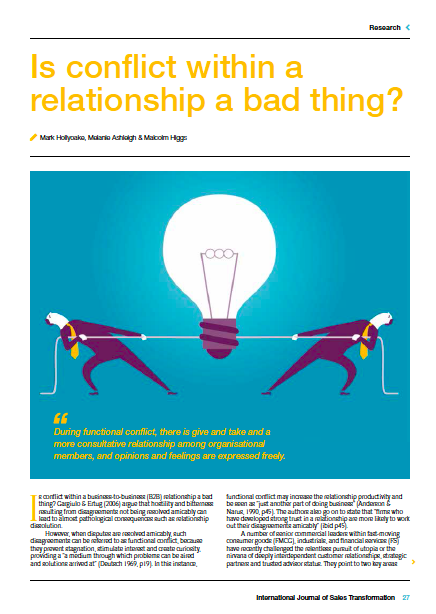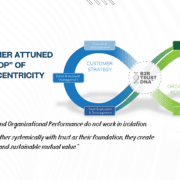Is conflict within a B2B relationship a bad thing? Part 1 of 3
In the first of three blogs we explore how you can use it to your advantage to prevent relationships from becoming over dependent.
This blog has been published in The Journal of Sales Transformation – scroll down to read the full article.
The problem with over-dependence:
Our discussions with senior commercial leaders highlight two major problems governing B2B relationships:
- Over investment within relationships that are never going to be more than transactional.
- Over dependence that has the potential to deliver relationship catastrophe if it implodes or a gradual reduction in value as it declines.
A significant amount of business is concentrated within the hands of the ever more demanding few. Many have experienced a customer using coercive power to gain a relational advantage, some would call this opportunism. Some also find themselves taking over a customer, or managing others, and finding the customer relationship is ‘too cosy’. The benefits (performance) for both sides have been in gradual decline for a while, yet the relationship remains positive.
These are signs of relationships which are over-dependent through excessive trust, and result in the following problems:
- Trust diminishes information gathering and processing costs by reducing the need for monitoring and vigilance, however it can lead to blind faith, which substantially increases the risk of malfeasance.
- Trust leads to greater satisfaction with and commitment to a relationship which can lead to complacency and acceptance of less than satisfactory outcomes.
- Trust leads to expanded communication and strategic information exchanges but over –embedded relationships can also create unnecessary obligations between parties.
(Gargiulo & Ertug 2006)
Does the above sound familiar? Relationships like this can often suffer long term decline, yet remain fairly positive, (they can be rescued before they wither, which we will cover in coming articles).
Frequently within B2B relationships a personal dynamic emerges as ‘one to one’ contact develops: ‘that’s Harry’s customer, everything has to go through him and Harry deals with Bill’, a similar gate-keeper, on the customer side of the business. This way of doing business is still prevalent in many sectors: Industrials, Financial Services and Investment banking B2B to name but a few. When exploring the sub-prime fiasco, in the U.S and subsequent financial meltdown, it was obvious that over-dependent relationships played a key part, turning a blind eye to the obvious, until too late. This is a stark indicator of what can happen when these relationships implode.
This type of negative gate-keeping relationship also extends to intra-group and/or intra-entity trust: People with strong bonds tend to build self-reinforcing business processes that make them less able to adapt to environmental changes which can amplify the cost of corrective action.
High trust breeds strong bonds of familiarity and mutual understanding that greatly facilitate cooperation. However, this may also filter information reaching key relationship partners. This generates a cognitive ‘lock-in’ that isolates the firm from the outside world and can cause relational inertia, making high trust relationships extremely resilient to losses in their instrumental value.1 In essence, excessive trust in one’s partner delays the triggering of corrective action facing an objective performance decline, which causes larger and more sustained losses in benefits for the trustor before corrective action is ultimately engaged upon.
Customer relationships can go into decline when on the surface everything looks fine. The development of excessive trust and overdependence can cause the relationship to operate in a bubble or lock-in. It’s important your customer relationships don’t go from strategic partners into ‘dependent’ trusted advisor, and tip over into over dependence through excessive trust, leaving you vulnerable.
Read the full article featured in The International Journal of Sales Transformation by clicking on the images below.
If you’d like to know more about The International Journal of Sales Transformation, click here.
Have a view on this? Tweet to @customerattune or Tweet to @MarkHollyoake
- Excessive Trust – When Trust Goes Wrong - October 29, 2024
- Identification Based Trust - October 21, 2024
- Introducing Knowledge Based Trust - October 15, 2024






